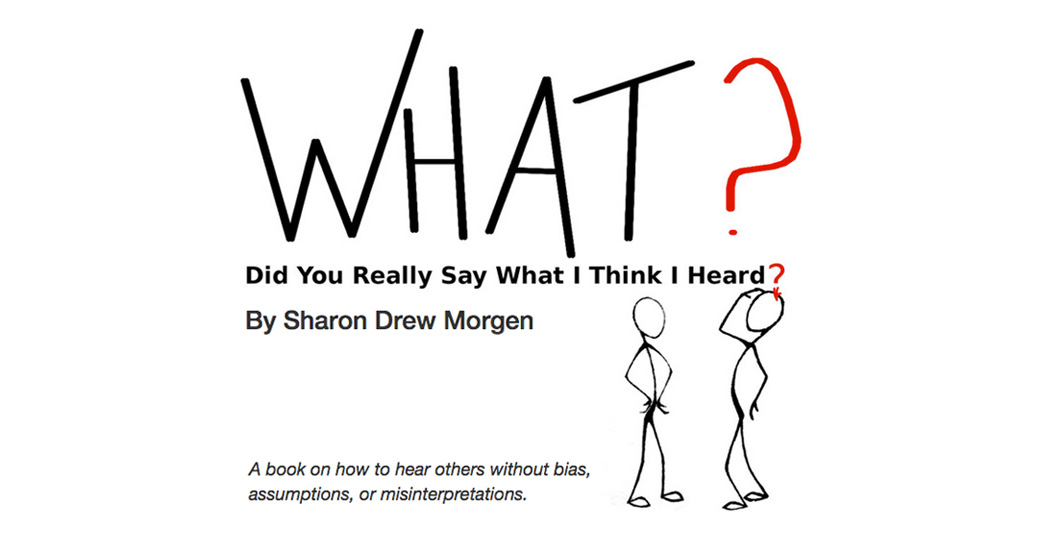Content Doesn’t Persuade: why pitching, marketing, idea-sharing, and training get limited success, by Sharon-Drew Morgen
 Are you seeking funding for a truly unique solution and it’s not getting the attention it deserves? Do you have a great solution you’ve created great content for and it’s still not closing as many sales as it deserves to? Do you have an idea that will correct long-held problems, but no one wants to hear it?
Are you seeking funding for a truly unique solution and it’s not getting the attention it deserves? Do you have a great solution you’ve created great content for and it’s still not closing as many sales as it deserves to? Do you have an idea that will correct long-held problems, but no one wants to hear it?
You know your solution is terrific and your pitch (deck) is creative, professional, and represents exactly what you want to say.You know your idea is important and sorely needed and your case study is on target and proves your conclusion. And yet. People aren’t buying; funders aren’t funding; people have no interest in adopting your idea. What’s the problem?
The problem is that information – regardless how necessary, relevant, or inspirational – doesn’t necessarily convince or cause action. Let me explain.
INFORMATION AND DECISION MAKING
As a culture, we tend to believe that content is a necessary part of decision making. This is true…but only marginally: people need content after they’ve already determined if, when, how, and why they would consider doing something different.
Here’s an example. Let’s say you need to purchase new software. Your team has theoretically agreed to make a change, but want to understand the risks: the amount of resource needed to maintain the new, the ‘cost’ (downtime, familiarity of use, etc.) of integrating the old with the new, or how jobs and daily work routines will be affected. Until they’re ok with the risks, they won’t make the purchase.
Ultimately change is a risk issue: the cost – the resource, the output – involved in doing something different must be less than the cost of maintaining the status quo; otherwise the risk of disrupting what works is too high. And until the risks are known, marketing information is irrelevant, and pitching, lecturing, graphics, storytelling and proof will be ignored, regardless of the efficacy of, or need for, the new ideas.
Unfortunately, most startups/scaleups seek funding on what they perceive to be the strength of their content and overlook the private risks, values-based criteria, and prior relationships, that funders must address. Professors, coaches, and leaders want their ideas to be heard, but often they end up being disregarded because the old ideas are normalized and imbedded into standard practice. [Watch my video on a new training model that works with the brain first before offering content resistance.]
The acceptance, the funding, the recognition you deserve won’t be acted upon because of the strength of your content; unless folks understand their risk of changing what they’ve got in place – the relationships, promises, beliefs, habits – they will hear you with biased ears.
CONTENT DOESN’T PERSUADE
We spend large sums of money to generate content for marketing, ads, sites, pitch decks, graphics, training, and outreach. But it only works when it works… and even then we don’t know how or when or why. A sales pitch closes 5%; Behavior Modification has a 3% success rate even though folks really want to change bad habits; doctors, coaches, leaders, and parents provide important details for change, and it falls on deaf ears.
The problem is how, when, why we share information. Pitching and content sharing assume that, if presented properly, good ideas and solutions will be accepted. But there’s no way to track, discover, expand, or connect with the unconscious decision-making criteria of the audience.
I recently got a call from a Venture Capitalist who’d been referred to me by an internationally famous change agent. He said he invests in Behavior Modification apps for weight loss and habit change, admitting that they were only 3% successful and the folks who purchased his apps would probably fail. Could I develop a change facilitation model that would really work? I knew he wasn’t familiar with my innovative ideas, so before pitching I asked:
SD: How would you know that my brain-change models would offer value?
DH: If you’ve been published in “Science.”
And there’s the crux of the problem. Yes, I’m an original thinker with bestselling books and proven models. And I was referred to him by the best. But I don’t have a PhD, causing science journals to reject my work. Our conversation was over. My great content, referrals, and accolades – even his own failure rate!… were useless because I failed to meet his criteria based on his idiosyncratic beliefs.
OUR BRAIN IS THE PROBLEM
It’s only when
- we recognize it’s time to make a change,
- the status quo isn’t working,
- there’s no familiar workaround to fix the problem,
- our core beliefs are in agreement,
- the risk of change is understood and planned for
that content is sought. Indeed, several industries fail because of their over-reliance on content:
The sales model assumes that content – pitching, marketing, advertising – causes sales. Although using the sales model alone (see my Buying Facilitation® Pre-Sales change management model) merely closes 5% – a whopping 95% fail rate! – sales continues to push content as a purchase motivator, blaming the ‘stupid buyers’ for the problem.
Healthcare pushes habit change and fails 97% of the time.
Trainers and coaches push new ideas and come up against resistance 80% of the time.
Leaders push initiatives and fail to generate lasting change 95% of the time, and managing resistance in the process.
Climate Tech startups and scaleups have been depending upon pitch decks to explain the value of their solutions, believing that a compelling story will raise funds. But given the range of new solutions entering the market, it’s necessary to address a funder’s possibly unconscious beliefs.
You see, decision making depends on our brain:
- Our brain may not decipher intended meaning. Because of the way sound vibrations enter ears and get dispatched for translation, we only translate incoming content according to the brain circuits we already possess (causing our biases). Our brain may not interpret new information properly and actually mistranslate or misunderstand, regardless of the relevance or presentation style of the data. I wrote a book on this (WHAT? Did you really say what I think I heard?).
- Everything we do is systemic. We’re each a unique system of rules and roles, history and hopes, values and beliefs. Decisions get made systemically and systems fight hard to maintain themselves. When one bit of the system is being asked to change without buy-in from the rest of the system, we get (you know this!) resistance and failure.
- Everything we do and say arises from our brains. Without our neural circuits prompting action, no decisions occur. And unless the risk of change is known and each relevant element of the failed system is managed, the brain won’t know how to make use of content as it will be too busy defending its system.
- Change, decisions, actions, arise from our baseline beliefs. Indeed, behaviors are beliefs in action. If any of the content elements you’re offering goes against the Other’s system or beliefs it will be rejected, mistranslated, or ignored, regardless of its intention or relevance.
Our devotion to content is costing us lost sales, shortened lifespans, and failed relationships.
WHAT DO WE DO INSTEAD?
I suggest we begin by helping Others figure out their own criteria and then offer the content that fits.
- How does your audience know when it’s time to make a change? How do they recognize incongruences that are costing them failure and possibility? (Hint: unless an incongruence is noticed, the brain will fight change.)
- How would they know that you would be a successful leader? A good steward for a start up in your industry?
- What would investors need to consider to believe a new solution would be relevant and successful?
This tactic would not only begin a collaborative dialogue before you present your content, it would cause an interaction that would promote a real relationship. Plus, once you’ve brought the unconscious beliefs to the surface, you’ll have a pathway to discuss how they might be ameliorated if a problem emerges. My clients create pitches and pitch decks that match unique beliefs and considerations, showing only those that apply.
For those wishing to learn how to formulate your specific upfront questions, I’d be happy to discuss them. In the meantime, go to www.sharon-drew.com and do a search for ‘questions’ and read my articles on the specific topic.
________________________________
Sharon-Drew Morgen is a breakthrough innovator and original thinker, having developed new paradigms in sales (inventor Buying Facilitation®, listening/communication (What? Did you really say what I think I heard?), change management (The How of Change™), coaching, and leadership. She is the author of several books, including her new book HOW? Generating new neural circuits for learning, behavior change and decision making, the NYTimes Business Bestseller Selling with Integrity and Dirty Little Secrets: why buyers can’t buy and sellers can’t sell). Sharon-Drew coaches and consults with companies seeking out of the box remedies for congruent, servant-leader-based change in leadership, healthcare, and sales. Her award-winning blog carries original articles with new thinking, weekly. www.sharon-drew.com She can be reached at sharondrew@sharondrewmorgen.com.
Sharon Drew Morgen April 7th, 2025
Posted In: News


